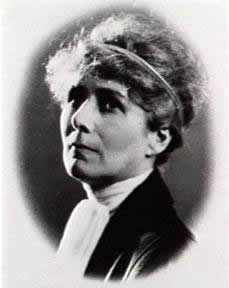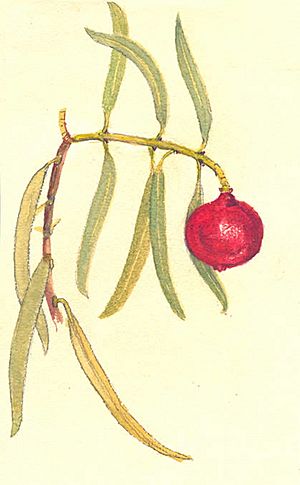Olive Pink facts for kids
Quick facts for kids
Olive Pink
|
|
|---|---|
 |
|
| Born |
Olive Muriel Pink
March 17, 1884 |
| Died | July 6, 1975 (aged 91) |
| Nationality | Australian |
Olive Muriel Pink (born March 17, 1884 – died July 6, 1975) was an amazing Australian woman. She was a talented botanical illustrator, someone who studied people and cultures (an anthropologist), a gardener, and a strong supporter of Aboriginal rights.
Olive spent much of her life fighting for better rights and living conditions for Australia's Indigenous people. She was very passionate about this cause. She never married, as she lost a close friend, Harold Southern, who was an artist killed in a war in 1915. Later in her life, Olive focused on plants and started a special garden in Alice Springs. Today, this garden is known as the Olive Pink Botanic Garden.
Contents
Early Life and Art Skills

Olive Pink was born in Hobart, Tasmania. She was the oldest child of Robert Stuart Pink and Eveline Fanny Margaret. Olive went to Hobart Girls High School and later studied art at Hobart Technical School. Her teacher was a famous artist named Benjamin Sheppard. In 1909, she even became a staff member at the school.
After her father passed away in 1907, Olive moved with her mother and brother. First, they went to Perth, Western Australia in 1911. Then, in 1914, they moved to Sydney. In Sydney, Olive taught art lessons to students both privately and at girls' schools.
In 1915, she started working for the New South Wales Department of Public Works. She had also earned a diploma in Town Planning the year before. Later, she worked for the NSW Government Railways and Tramways. There, she designed different advertising posters. During this time, she improved her art skills by taking classes at the Julian Ashton Art School. This was a very important art school in Australia.
Exploring Central Australia
In 1926, Olive went on a holiday to a remote place called Ooldea, South Australia. It was on the edge of the Nullarbor Plain. She went with Daisy Bates, a well-known social worker and anthropologist. This trip was Olive's first time experiencing Aboriginal culture.
In 1930, Olive lost her government job. Since she was very interested in the remote countryside, she traveled to central Australia. There, she sketched many different desert plants.
She then returned to Sydney and studied anthropology at the University of Sydney. She also became the secretary for the Anthropological Society of New South Wales. From 1933 to 1936, she received money from the Australian National Research Council. This allowed her to work with the Arrernte people near Alice Springs. She also worked with the Warlpiri people in the Tanami Desert.
Olive wrote several papers about the Arrernte people in 1933 and 1936. However, she chose not to share her work on the Warlpiri people. She respected their culture and privacy. During this time, she also met the famous artist Albert Namatjira. She bought two of his early paintings. They remained friends until he passed away in 1959.
Advocating for Aboriginal Rights
Around this time, Olive Pink began to speak out strongly for Aboriginal people. She wrote many letters to politicians and newspapers. Her goal was to make people aware of the challenges faced by Aboriginal communities. She openly criticized government officials, missionaries, and farmers.
Olive made strong demands and constantly pushed politicians for change. Her strong opinions sometimes led to her being investigated by authorities.
Olive lived with remote Indigenous communities for several years. She taught English and other skills. She even tried to create a special community for the Warlpiri people, but it didn't work out. In 1946, she moved to Alice Springs. She lived in simple huts and a tent on the edge of town. She earned money by selling fruit and flowers from her garden. She also showed her artwork in exhibitions.
During this time, she met artist Sidney Nolan and his wife. She shared her experiences with Aboriginal people with them.
Creating the Botanic Garden
In 1955, Olive asked for a piece of land near the Todd River in Alice Springs. She wanted to create a special reserve for plants. The next year, her request was approved. The land became known as the 'Australian Arid Regions Flora Reserve'. This happened with help from Sir Paul Hasluck, who was a government minister. Olive was then made the 'honorary curator' of the reserve. This meant she was in charge of looking after it.
Sir Paul Hasluck and Olive Pink wrote many letters to each other over the years. In 1975, after Olive passed away, he shared a funny story. He said that Olive planted trees in the reserve. With help from her Aboriginal assistant, Johnny Jambijimba Yannarilyi, she watered and cared for them. Each tree was named after an important person. If that person upset her, she would stop watering their tree! So, if a tree named 'Mr. Archer' looked sad, but 'Mr. Marsh' was green, you knew what had happened. Sir Paul said he always checked on his own tree, 'Mr. Hasluck', to see if it was being watered regularly.
Later Life and Legacy
Olive Pink lived in the plant reserve until she passed away. Her longtime friend and gardener, Johnny Jambijimba Yannarilyi, helped her. She died in Alice Springs, Northern Territory, at 91 years old. She passed away in the Alice Springs Hospital.
Olive is buried in the Alice Springs Memorial Cemetery. Her grave is in the section for the Quakers, a group she was close to. It is also near the Aboriginal section of the cemetery. Olive had a special request for her burial. Her gravestone faces west, which is different from others. This was so it would face Mount Gillen, a place she loved.
After she passed away, the beautiful garden she created was renamed the Olive Pink Botanic Garden. It was opened to the public in 1985.
Olive Pink left many of her pencil and crayon sketches to the University of Tasmania Library. She also gave several paintings by Albert Namatjira to the Tasmanian Museum and Art Gallery.

